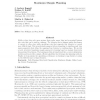Free Online Productivity Tools
i2Speak
i2Symbol
i2OCR
iTex2Img
iWeb2Print
iWeb2Shot
i2Type
iPdf2Split
iPdf2Merge
i2Bopomofo
i2Arabic
i2Style
i2Image
i2PDF
iLatex2Rtf
Sci2ools
101
click to vote
ICML
2006
IEEE
2006
IEEE
Maximum margin planning
Mobile robots often rely upon systems that render sensor data and perceptual features into costs that can be used in a planner. The behavior that a designer wishes the planner to execute is often clear, while specifying costs that engender this behavior is a much more difficult task. This is particularly apparent when attempting to simultaneously tune many parameters that define the mapping from features to resulting plans. We provide a novel, structured maximum margin approach to learning based on example trajectories demonstrated by a human. The learning problem is transformed into a convex optimization problem and we provide a simple, efficient algorithm that leverages fast planning methods. Finally, we demonstrate the algorithms performance on learning to map features to plans on two different types of input features.
Convex Optimization Problem | ICML 2006 | Learning Problem | Machine Learning | Maximum Margin Approach |
Related Content
| Added | 17 Nov 2009 |
| Updated | 17 Nov 2009 |
| Type | Conference |
| Year | 2006 |
| Where | ICML |
| Authors | Nathan D. Ratliff, J. Andrew Bagnell, Martin Zinkevich |
Comments (0)

